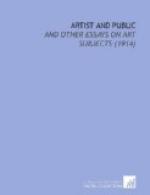The picture is exactly square—the choice of this form is, of itself, typically modern in its unexpectedness—and represents a bit of rough wood interior under intense sunlight. The light is studied for its brilliancy rather than for its warmth, and if the picture has a fault, granted the point of view of the painter, it is in a certain coldness of color; but such conditions of glaring and almost colorless light do exist in nature. One sees a few straight trunks of some kind of pine or larch, a network of branches and needles, a tumble of moss-spotted and lichened rocks, a confusion of floating lights and shadows, and that is all. The conviction of truth is instantaneous—it is an actual bit of nature, just as the painter found it. One is there on that ragged hillside, half dazzled by the moving spots of light, as if set down there suddenly, with no time to adjust one’s vision. Gradually one’s eyes clear and one is aware, first of a haggard human head with tangled beard and unkempt hair, then of an emaciated body. There is a man in the wood! And then—did they betray themselves by some slight movement?—there are a couple of slender antelopes who were but now invisible and who melt into their surroundings again at the slightest inattention. It is like a pictorial demonstration of protective coloring in men and animals.
[Illustration: Plate 21.—Sargent. “The Hermit.” In the Metropolitan Museum of Art.]
Now, almost any one can see how superbly all this is rendered. Any one can marvel at and admire the free and instantaneous handling, the web of slashing and apparently meaningless brush strokes which, at a given distance, take their places by a kind of magic and are the things they represent. But it takes a painter to know how justly it is observed. In these days no painter, whatever may be his deepest convictions, can escape the occasional desire to be modern; and most of us have attempted, at one time or another, the actual study of the human figure in the open air. We have taken our model into a walled garden or a deep wood or the rocky ravine of a brook and have set ourselves seriously to find out what a naked man or woman really looks like in the setting of outdoor nature. And we have found just what Sargent has painted. The human figure, as a figure, has ceased to exist. Line and structure and all that we have most cared for have disappeared. Even the color of flesh has ceased to count, and the most radiant blond skin of the fairest woman has become an insignificant pinkish spot no more important than a stone and not half so important as a flower. Humanity is absorbed into the landscape.




